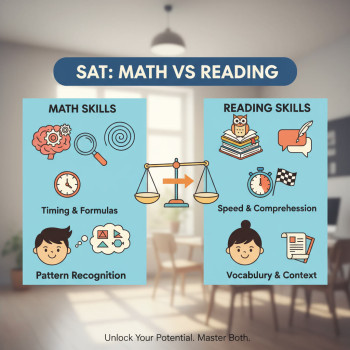Why timing your Digital SAT matters more than you think
College applications are a lot like auditions: the performance matters, but so does showing up on time. Your Digital SAT score can expand your options, unlock scholarships, and make your application look polished. But a great score that arrives after an early application deadline—whether it’s an Early Action, Early Decision, or a scholarship cut-off—doesn’t help the most. That’s why aligning test dates, score release timelines, and application deadlines is one of the smartest moves you can make.

Three big-picture principles to keep front-and-center
Before getting tactical, hold these three ideas in mind. They’ll help you make calm, effective choices instead of panicking near deadlines.
1. Start with the college deadlines, not the test dates
List every college you’re applying to and note their application deadlines—Regular Decision, Early Action, Early Decision I/II, and scholarship/priority deadlines. Those are your fixed anchors. Work backward from those dates to pick which SAT test dates will realistically allow your scores to arrive in time.
2. Know the typical score-release lag and add buffer
Digital SATs have a predictable schedule for score reporting. But “predictable” still means you should allow cushion time: plan for the published score release window plus a few extra days for any administrative processing (and for sending score reports to colleges). That buffer is especially important if you plan to use a late test date as your final chance to improve.
3. Treat your readiness as fluid, not fixed
Many students aim for a single “big test” and hope everything aligns. A better approach is staged readiness: do one early attempt to establish a baseline, learn from the score, then plan a targeted second attempt if needed. This gives you time to act on real data rather than guesswork.
Understanding the Digital SAT timeline (simple breakdown)
Here’s a practical way to think about the timeline from registration to a college receiving your score:
- Registration deadline for a test date — when you must sign up to take the test.
- Test date — the day you sit for the exam (Digital SATs typically occur on scheduled Saturdays).
- Score release window — when College Board processes and posts scores. Expect an official window; add 3–7 days as buffer if you’ll send score reports to colleges.
- College receipt — some colleges receive scores quickly; others take a few extra days to add them to your application file. If you’re near a deadline, you must account for this.
Because institutions differ, the safest rule is: get scores to colleges at least 5–7 business days before the posted deadline for the application portal or the scholarship. For Early Decision/Early Action, aim even earlier—10 business days if possible.
How to make a practical schedule: three scenarios
Below are sample plans for common student situations. Pick the one that most closely matches your circumstances and adapt it.
Scenario A — Early Action/Early Decision applicants (high urgency)
If you’re applying in an Early round (typical deadlines in November), you want at least one completed, scored Digital SAT before that deadline.
- Plan to take an August or September test if your colleges have November deadlines—this gives time for score release and sending reports.
- If you’re not ready then, consider a summer intensive or targeted 1-on-1 prep (personalized tutoring like Sparkl’s can be invaluable here) to accelerate progress for an October or early November test—only if your colleges accept that timing.
Scenario B — Regular Decision with flexibility
Regular Decision applicants (typical deadlines in January) have the luxury of more test dates. Use an earlier test for baseline data and schedule a final retake by December to give max time for score release and reporting.
- Baseline test: Early fall (September/October) to see strengths and weaknesses.
- Targeted retake: Late fall (November/December) after a focused study block.
- Buffer: Aim to have final scores visible to colleges by mid-December to early January depending on deadlines.
Scenario C — Scholarship or rolling admissions deadlines
Scholarship deadlines can be strict. Rolling admissions vary by college. For both, identify the earliest deadline and schedule an SAT date that ensures scores arrive comfortably before it.
- If a scholarship deadline is in December, a safe final test date is early November or earlier.
- For rolling admissions, earlier is better—don’t wait until the very last test date that still technically meets a deadline.
Sample schedule table: matching test dates to typical college deadlines
| College Deadline Type | Typical Deadline Month | Recommended Final Test Date (latest) | Why |
|---|---|---|---|
| Early Action / Early Decision I | November | August–September | Allows time for score release and any corrections; cushion for sending reports. |
| Early Decision II / Early Action II | January | October–November | Gives opportunity for a retake in October/November with scores in time. |
| Regular Decision | January | November–December | Final retakes in late fall let scores post before decision review. |
| Rolling Admissions | Varies (ongoing) | As early as possible | Early reporting strengthens your file; avoid last-minute submissions. |
| Scholarships / Priority Deadlines | Oct–Dec (often) | August–October | Some scholarships look at scores before applications are complete. |
How to pick which test dates to register for
Choosing test dates is about trade-offs: more prep time vs. later score release. Use this decision checklist:
- What are your earliest application deadlines? Work backward from the strictest one.
- How much time do you realistically need to improve from your baseline? Be honest—if you need months, schedule earlier tests as practice.
- Are you planning to send scores automatically or self-report? (For schools that allow self-reporting, you may control timing more precisely.)
- Do you qualify for fee waivers or require accommodations? These can require additional lead time for arrangements.
Practical steps for keeping scores aligned with deadlines
Here’s a tactical checklist you can use right now.
1. Create a master deadline calendar (digital + printable)
List every deadline and color-code them: red for early rounds, orange for scholarships, green for regular decision. Add the College Board test dates and their registration deadlines alongside. This visual pairing makes gaps or conflicts obvious.
2. Take a diagnostic early
A diagnostic test (real or official practice) gives you data to set realistic goals. If your diagnostic score is near where you want to be, one or two focused weeks of study may be enough. If you need a big jump, allocate months and schedule multiple test attempts.
3. Build a study block after each test
Treat every test as feedback. Plan a focused study block (4–8 weeks) after your baseline to target weaknesses. Structured approaches—like tailored study plans and 1-on-1 support—generally produce faster, more consistent improvement than unstructured studying.
4. Reserve the final applicable test date—not the absolute last one
If your deadline allows multiple test dates, choose the penultimate one that still leaves cushion for score release. That way, if something unexpected delays scores, you still have a fallback.
5. Use score send strategies thoughtfully
Decide whether to send all scores, send only your best, or self-report. Understand each college’s policy. If you want colleges to consider the highest evidence of readiness, send the test that best reflects that—but only if it arrives on time.
When to consider delaying an application vs. rushing a score
This is one of the hardest calls. If your final test date won’t realistically yield scores in time, you have two broad choices:
- Delay your application to the next cycle or regular round so you can aim for a stronger score.
- Submit your application without the final score but with a plan: include a short note in your application or counselor recommendation indicating that a score is forthcoming (only do this if the college accepts updates and you’re confident the score will arrive soon).
Most admissions officers prefer a strong, complete application over a rushed one with a late test that may not reflect your best work. Talk it over with your counselor or a trusted tutor; objective external input can make the decision clearer.
How parents can support the process without taking over
Parents play a huge role—logistical support, emotional encouragement, funding for prep resources—but the goal is to empower the student to take ownership. Here’s a helpful balance:
- Help build the master calendar and check registration deadlines. (Dates and registration cutoffs are firm.)
- Encourage consistent study windows and respect student ownership of practice and test-day routines.
- Ask open questions: “What score would make you proud?” rather than “Shouldn’t you get a higher score?”
- Consider investing in targeted tutoring if the student is close but needs strategy or content help—personalized 1-on-1 options, like Sparkl’s tutoring model, can focus on the exact gaps and speed improvement.
Real-world examples: three student stories
Concrete examples are often the clearest teachers. These short vignettes show how timing decisions play out.
Alex — Early Action sprint
Alex planned for Early Action in November but a September baseline score showed a 40-point gap from his target. He used a targeted 6-week study block with twice-weekly one-on-one sessions focused on timing and data interpretation. He retook the test in October and improved enough to feel confident submitting his Early Action in November. The fast, personalized help made the difference.
Priya — Regular Decision strategy
Priya took a diagnostic in August, then a first official test in September for practice. Her September score helped her identify weaknesses in data interpretation. She scheduled a focused study plan and a November retake, which posted in time for her January Regular Decision deadline. Staged testing reduced stress and improved her score trajectory.
Jordan — Scholarship deadline dilemma
Jordan had a scholarship deadline in December but didn’t have scores until mid-December. Rather than rush, Jordan and his counselor decided to submit an application highlighting achievements and a note that a final SAT score was forthcoming. He took the December test, and the scholarship committee accepted the update a few days later. The key was clear communication and early coordination.
Tools and study approaches that actually move the needle
Not every study hour is equal. Here are methods that consistently show real results, especially when paired with a plan that aligns to deadlines:
- Deliberate practice on weak question types—small targeted sets with immediate review.
- Timed full-length practice tests in the exact digital format you’ll see on test day.
- Data-driven review: track error types and correct them with mini-lessons rather than repeating whole sections.
- One-on-one tutoring for targeted strategy, timing, and personalized feedback—this is where tailored plans like Sparkl’s 1-on-1 guidance can speed progress dramatically.
Checklist to use 8–12 weeks before a deadline
- Create your master deadline calendar with test dates and registration cutoffs.
- Take a diagnostic or official practice test to set a baseline.
- Decide on a baseline test date and a target final date with buffer days for score release.
- Choose a study method: self-study plan, small group class, or 1-on-1 tutoring.
- Register early for the test to lock in a seat and avoid late fees.
- Plan logistics (device setup, test-day supplies, rest days near test day).
How to handle score submission and updates
Once your scores are released, act promptly:
- Send official score reports to the colleges on your list as soon as you confirm the score you want them to see.
- If you self-report in the application, follow each college’s rules—some require official scores later, some do not.
- If a score is late, contact the admissions office politely, explain the timing, and ask if they will accept an updated score—often they will if you explain calmly and provide a clear timeline.
When personalized tutoring is the right move
Not every student needs 1-on-1 tutoring, but personalized help is a force multiplier when:
- You need specific strategies to shave time or avoid careless errors.
- Your diagnostic shows clear, fixable patterns of mistakes.
- You’re close to your target score but need the final push before a critical deadline.
One-on-one tutoring—especially with a tutor who can craft a tailored study plan, offer focused practice, and use AI-driven insights to track progress—can accelerate gains in a short time. If you are balancing schoolwork, activities, and an early deadline, targeted tutoring (for example, Sparkl’s personalized model that combines expert tutors with tailored plans and AI insights) often makes that final stretch manageable and efficient.
Common scheduling mistakes and how to avoid them
- Waiting until the last possible test date: choose the penultimate test that still gives buffer time.
- Ignoring registration deadlines: those cutoffs are firm—miss them and you may be out of luck or face extra fees.
- Underestimating score release windows: allow a conservative buffer of several extra days beyond the posted timeline.
- Assuming all colleges process scores the same way: call or email the admissions office if you’re unsure—clarify how they handle late or updated scores.
Final thoughts: Calm planning beats last-minute panic
Aligning your Digital SAT schedule with college deadlines is less about magic and more about disciplined planning. Start with deadlines, take an honest diagnostic, schedule staged testing, and give yourself buffer days. Use data to drive study choices and consider personalized one-on-one tutoring when you need focused gains quickly—especially if time is short. With a clear calendar and steady work, you’ll reduce stress and give your application the best chance to shine.

Quick action plan (printable, 6 steps)
- Make your master deadline calendar today—include every college and scholarship date.
- Take a full-length Digital SAT practice test as a diagnostic.
- Choose your baseline and final test dates with at least a 5–7 business day buffer for score release (10 days for early rounds).
- Create a focused study plan of 4–8 weeks between tests; include timed practice and error logs.
- Decide on score-sending strategy early and register for your final chosen test—don’t wait.
- If time is tight, book targeted 1-on-1 sessions to accelerate progress and ensure readiness.
One last reassurance
This process feels big because college matters—and because you care. But by turning big goals into a few clear calendar decisions and smart study choices, you take the power back from stress. Treat each test as information, not judgment. Adjust based on data, and remember: many students find strategic help—targeted tutoring, structured practice, and calm planning—to be the difference between scrambling and succeeding.
If you’d like, I can help you build a personalized timeline right now: tell me your list of colleges and their deadlines, your current diagnostic score (or a recent practice score), and which months you’d prefer to test. We’ll make a plan that fits your life and helps your best work show up on the calendar.














No Comments
Leave a comment Cancel